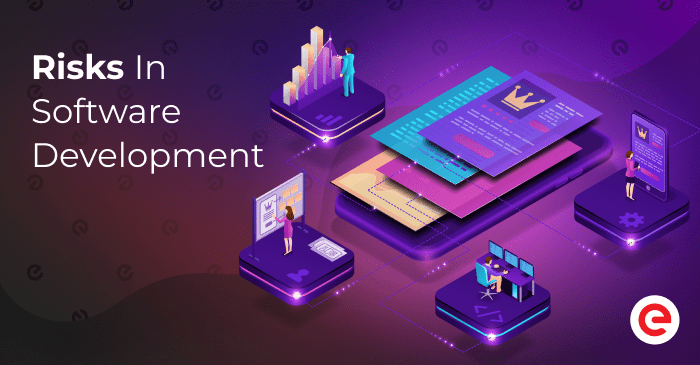
Updated: May 10, 2024
Published: August 11, 2017
Nowadays, we can observe trends for improvement in the methodology of software development, setting up clear goals, restrictions, expectations, and risks. Flexible models of custom software development are the most prospective in this direction. Considering the overall structure of flexible methodologies, we can see the relevance of risks in software development assessment. This is especially important now with the rising occurrence of cyber-attacks, vulnerabilities, and software risk issues. Unfortunately, it is hard to take into account all of these factors because of a number of subjective and objective reasons. Partially this happens due to a lack of structured knowledge in this area. Here we present the main software development risks you can meet. We will not only describe them for you to be aware of, but also we will try to explain how to avoid these types of risks in software engineering.
List of the content
- Schedule risks
- Budget risks
- Technical risks
- Management risks
- External risks
- Managing risks in software development
- Best practices for managing risks in software development
- Conclusion
SCHEDULE RISKS IN SOFTWARE DEVELOPMENT

While creating a plan, the managers are often guided by the customers’ wishes or the team’s excessively optimistic estimation. As a result – the significant difference between the planned and real terms increases by 50-80%. If that happens, misunderstandings with the customer and resource overspending are inevitable consequences.
In this case, the programmers are often blamed for the software development risks. But this inaccuracy – is management’s fault. Sometimes the opposite situation is met when the realization term is inflated. In this case, it is very easy to lose a customer because “someone else” can do this faster and cheaper.
To reduce the schedule risks in software development, it is important to have some time reserved for case of planning issues and unforeseen circumstances. And, of course, for the best schedule, you should involve the developers in terms of estimation.
BUDGET RISKS IN SOFTWARE DEVELOPMENT

Correct financing is a process that requires the utmost attention to avoid risks in software development. The finance distribution will later lead to the reasonable use of the finances and overall project success. But what if the situation is the opposite? What if the finance manager has decided to make a retrenchment on that or another aspect? This is not obligatory to occur, but such actions may lead to the lowering of the quality of the used resources. In its turn, it leads to another waste of time and waste of resources for solving emerging problems.
Of course, if it is about the agile software development life cycle model, where the budget is not preliminarily assigned, this problem looks impossible to happen. This model includes the fact of unpredictable financial input. But unfortunately, the customer’s resources aren’t limitless. That means the number of new feature implementations, error fixes, testing – everything requires financial input. And the more new things appear – the more expensive it becomes. But that’s not all. The new features implementation may cause a conflict with the existing system, which in turn needs fixes. The situation may repeat until one day, the project is found in the “development hell”. After that, there are only two options for the project – the trash can or the painful recovery. This shows that incorrect or uncontrolled financing will ruin the project. The solution for this is wise finance distribution and initially putting the project in tight frames. The risks in software development are unpredictable, but there are ways to avoid them by having reserved funds for such cases.
What are the average software development rates?
Download the report for a comprehensive pricing analysis of the most popular onshore and offshore outsourcing locations. Hourly rate cards for these territories are included.
TECHNICAL RISKS IN SOFTWARE DEVELOPMENT

If there is no active demand for the developer’s redistribution to the unknown tasks – the probability of the risks in the software project tends to be a minimum. The only possible source of it is in management, so its effective minimization lies within the administration alteration. But despite it, such software development risks should be minimized, and many methods exist. The essence of these methods is in the rise of the transparency of the project. The more structured the project is, the clearer its source code and documentation are – the less time the developer spends on familiarizing it. This activity is very important because statistics say that project support and maintenance are performed by up to 10 generations of developers.
For the project to have a clear structure, all the construction stages should be aimed at simplification. This activity includes building the best project decomposition: modules, classes, identifiers, comments, etc. Ignoring the complexion minimization leads to issues with the new man next to the old code and its common writing. The reason is that one man will not handle the modification of a large volume of code.
MANAGEMENT RISKS IN SOFTWARE DEVELOPMENT

One of the most significant management risks in software development is within the team structure. As for the first time, the new team members will work slower and make mistakes. If the settled team during the long term of coworking gets used to cooperating with each other, it is difficult to let the new member in, no matter how good a programmer and/or person they are. The management task is making comfortable conditions for everyone to keep on developing the product. In the other case, the weak member will draw the team to the inevitable failure.
But this is the coin of two sides. The management can also not be the best indication of the well-going process. The manager is the mediator between the engineering team and a customer or project manager, whose role is to make requirements to be implemented. The manager should be clear on both sides. If the manager did not get the customer’s words clearly but made a fine explanation to the team – the developers would still fail to follow the instructions. Or the situation opposite, if the manager cannot bring a good explanation to the team – the work may not even begin.
The solution is – fine management. If the team manager, scrum master, or someone else is going to work with a team for the first time – they will need a testing period. During this time becomes clear how well the team and its manager understand each other and how well they can perform together.
EXTERNAL SOFTWARE DEVELOPMENT RISKS

The world tends to evolve and change. Not only its behavior but its needs change as well. When the market needs change, there is a risk of product development that is no more in demand. And here are two ways to continue: collapse the project or try to fit it to the existing market requirements. But the second option will need additional financial input, and we have already mentioned what it causes.
There is no solution to such a problem but good business analysts. These people monitor the market looking for the best way to lead the project’s development. They will not avoid the problem but will bring the solution.
Another example of the risks in software development is the poor level or even full absence of user feedback. No matter how big it is, the internal testers team will not find all the bugs and flaws in the software. The reasons are varied, and the main one is the lack of time for proper testing. So for the developer that cares about his product and user experience, feedback is very important. Even if users have many complaints – it is good if the team listens to the feedback and makes the required changes. But if the feedback is poor – there “is nothing to fix”. Users do not complain about the issue, the developer does not fix it, users stop using the software, and in some time, it is not needed anymore.
To prevent this from happening, you should wisely allocate the time for testing. Time reduction to a minimum will leave tons of bugs in the release version. At the same time, delaying it until no one is interested in the product anymore – is also a bad idea.
Have additional questions on how to eliminate these flaws?
Visit our Dedicated Development Team section to learn how the flexible outsourcing strategy eliminates flaws in human resources and development costs.
MANAGING RISKS IN SOFTWARE DEVELOPMENT
Managing risks in software development is a crucial aspect of the software development process. Risks can arise from various factors, including technical challenges, project management issues, and business-related concerns. To manage risks effectively, it is essential to have a structured approach that involves risk assessment, risk mitigation, risk monitoring and control, and risk response planning. Let’s consider each stage:
Risk assessment: The first step in managing risks is to conduct a risk assessment. That involves identifying potential risks that may arise during the software development process. Risk assessment can be done by conducting a brainstorming session with project stakeholders, reviewing historical data, and conducting surveys or interviews with experts in the field. Once the risks have been identified, they can be prioritized based on their likelihood and impact.
Risk mitigation: It involves reducing the likelihood or impact of identified risks. It can be done by implementing preventive measures, such as improving the software design or selecting more reliable technologies. Risk mitigation can also involve developing contingency plans to address potential issues, such as having backup resources or developing alternative software solutions.
Risk monitoring and control: It covers tracking and evaluating risks throughout the software development process. That involves implementing measures to detect and address risks as they arise, such as conducting regular testing or monitoring project progress against established milestones. Risk monitoring and control also involve tracking and evaluating risk mitigation measures to ensure they are effective.
Risk response planning: It goes with developing a plan to respond to identified risks. This involves developing a detailed response plan for outlining the steps taken in the event that risk materializes. The response plan should be communicated to project stakeholders and regularly reviewed and updated as needed.
By managing risks effectively, organizations can minimize the potential impact of risks on the software development process, reduce project costs, and ensure that software development projects are completed on time and within budget.
BEST PRACTICES FOR MANAGING RISKS IN SOFTWARE DEVELOPMENT
Managing risks in software development can be challenging, but there are several best practices that organizations can follow to ensure that risks are effectively managed throughout the software development process. These best practices include:
- Establish a risk management plan: This plan should outline the overall approach to managing risks, including the processes for identifying and prioritizing risks, the methods for mitigating and monitoring risks, and the procedures for responding to risks that materialize. The risk management plan should be communicated to all project stakeholders and reviewed and updated regularly.
- Identify and prioritize risks: That covers conducting a comprehensive risk assessment to identify potential risks and then prioritizing those risks based on their likelihood and potential impact. Once risks have been prioritized, resources can be allocated to address the highest-priority risks.
- Allocate resources: The third practice includes allocating time, personnel, and financial resources to address high-priority risks. Resource allocation should be based on the potential risk impact and the likelihood of the risk materializing.
- Set up a feedback loop: This involves regularly reviewing and evaluating the risk management plan and the effectiveness of risk mitigation measures. Feedback can be obtained from project stakeholders, team members, and external experts to ensure that the risk management plan is effective.
- Involve stakeholders: It’s important to involve project sponsors, customers, and end-users in the risk assessment and risk management processes. By engaging stakeholders, organizations can ensure that risks are identified and managed in a way that aligns with the needs and expectations of all stakeholders.
Managing risks in software development requires a structured approach. By following these best practices, organizations can effectively manage risks and ensure the success of software development projects.
CONCLUSION
In general, it can be noted that the proper and correct application of assessment methods and software development risk management can significantly improve the quality and safety of the product developed at relatively moderate costs. Thus, given the effectiveness of different methods, it seems that the most effective way of using them is together to keep the project safe.
What risks in software development do you consider the most threatening?
Share your opinion with Existek’s team of experts and contact us directly to discuss how we can help you minimize project risks.
Frequently asked questions
What are the top 5 risks in software development?
Risks of software development can be divided into the following categories:
Schedule risks
Budget risks
Technical risks
Management risks
External risks
How to manage risks in software development?
Managing risks is an essential aspect of the development process. These are some steps you can take to address them:
Identify potential risks
Prioritize risks
Develop a risk management plan
Assign responsibilities
Monitor risks
Adapt the risk management plan
What are the best practices for managing risks?
Establishing a risk management plan
Risk identification and prioritization
Resource allocation
Feedback loop setup
Stakeholders engagement
